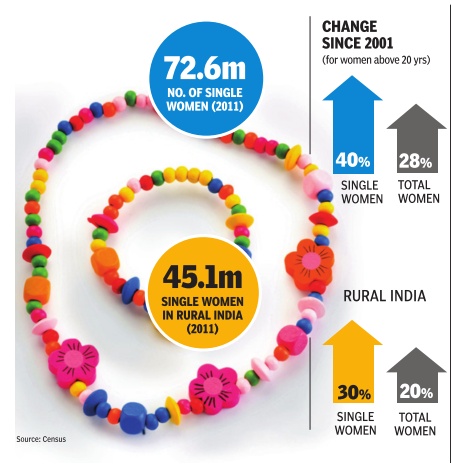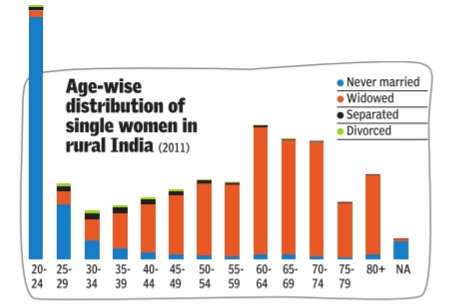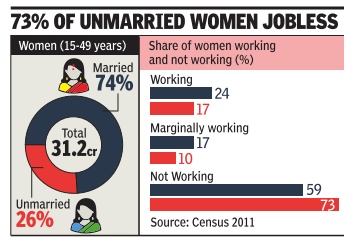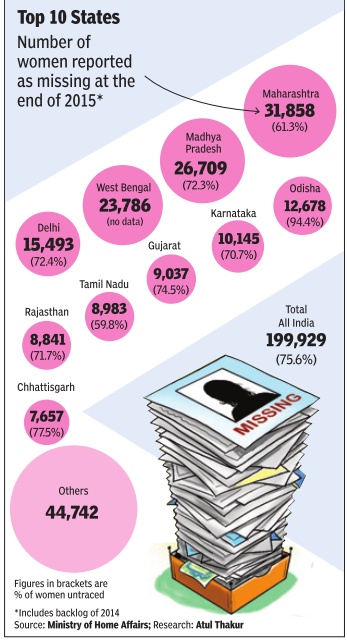Women, the status of, in India
(→Single women in India) |
|||
| Line 15: | Line 15: | ||
[[File: Number of single women, total and in rural India, 2011.jpg| Number of single women, total and in rural India, 2011; Graphic courtesy: [http://epaperbeta.timesofindia.com//Article.aspx?eid=31808&articlexml=ONLY-AND-OFTEN-LONELY-22112015023017 ''The Times of India''], November 22, 2015|frame|500px]] | [[File: Number of single women, total and in rural India, 2011.jpg| Number of single women, total and in rural India, 2011; Graphic courtesy: [http://epaperbeta.timesofindia.com//Article.aspx?eid=31808&articlexml=ONLY-AND-OFTEN-LONELY-22112015023017 ''The Times of India''], November 22, 2015|frame|500px]] | ||
[[File: Age-wise distribution of single women in rural India, 2011.jpg| Age-wise distribution of single women in rural India, 2011; Graphic courtesy: [http://epaperbeta.timesofindia.com//Article.aspx?eid=31808&articlexml=ONLY-AND-OFTEN-LONELY-22112015023017 ''The Times of India''], November 22, 2015|frame|500px]] | [[File: Age-wise distribution of single women in rural India, 2011.jpg| Age-wise distribution of single women in rural India, 2011; Graphic courtesy: [http://epaperbeta.timesofindia.com//Article.aspx?eid=31808&articlexml=ONLY-AND-OFTEN-LONELY-22112015023017 ''The Times of India''], November 22, 2015|frame|500px]] | ||
| + | |||
| + | =Indian women: an economic profile= | ||
| + | [http://epaperbeta.timesofindia.com/Article.aspx?eid=31808&articlexml=More-married-women-at-work-than-single-Census-19122016001038 ''The Times of India''], Dec 19 2016 | ||
| + | |||
| + | [[File: Share of women working and not working, 2011.jpg|Share of women working and not working, 2011; Graphic courtesy: [http://epaperbeta.timesofindia.com/Article.aspx?eid=31808&articlexml=More-married-women-at-work-than-single-Census-19122016001038 ''The Times of India''], Dec 19 2016|frame|500px]] | ||
| + | |||
| + | '''More married women at work than single: Census''' | ||
| + | |||
| + | Subodh Varma | ||
| + | | ||
| + | How does marriage af fect a woman's job pro spects, and later, how does she negotiate issues like the number of children and their gender? Recently released Census 2011data offers some interesting insights. | ||
| + | Among those in the childbearing age of 15-49 years, married women are more likely to be working than unmarried women. Those with regular jobs are also likely to have fewer children. But there is a downside to this: with fewer children, the preference for a son becomes an overriding factor, causing a fall in the sex ratio. The lot of nonworking women, who make up the majority , is no better.Confined to “domestic duties“, they not only have more children than working women, the sex ratio among their children is much worse, indicating a stronger stranglehold of patriarchal values. | ||
| + | |||
| + | In the child-bearing age group, just 27% of unmarried women are working compared with 41% among married women. Experts say that most unmarried women are young and families don't allow them to go out to work.Some are students in higher levels of school or college. The total fertility rate or average number of chil dren born to a woman over her full child-bearing years has dipped to 2.9 for working women from 3.3 a decade ago. | ||
| + | |||
| + | On the other hand, the fertility rate is higher at 3.1 among non-workers, only marginally down from 3.2 in 2001.In both cases, the sex ratio of children born in the last year is falling, but more so among working women -from 912 in 2001 to 901 in 2011. Among nonworkers, the sex ratio fell from 901to 894 in this period. | ||
| + | |||
| + | Marginal workers -women who have irregular or casual jobs for less than six months in a year -show the tense equation between a desire to limit children and son preference. The fertility rate is still high among them at 3.4 though down from 3.7 a decade ago. But the sex ratio has slightly improved from 911 in 2001 to 914 in 2011. Economic reasons may prevent such women and their families from accessing sex-selective abortions, often forcing more pregnancies in pursuit of sons. Also, underprivileged sections like tribals and Muslims form a larger chunk of marginal workers and sex-selective abortion is not as acceptable in these communities. | ||
| + | |||
| + | The wide chasm between urban and rural India is a striking feature of this data.Half of the married women in rural areas work while in urban areas just 22% go out for jobs. In urban areas, fertility rates have dropped drastically with women main workers having just 2 children on an average compared to 3.1 for their rural counterparts. | ||
| + | |||
| + | Side by side, sex ratio too has suffered a chilling decline from 936 to 906 for them, the biggest decline among all economic groups. | ||
=Crime against women: 2015= | =Crime against women: 2015= | ||
[[File: Women reported missing, 2015.jpg| Women reported missing: 2015; Graphic courtesy: [http://epaperbeta.timesofindia.com/Article.aspx?eid=31808&articlexml=STATOISTICS-280-WOMEN-WENT-MISSING-EVERY-DAY-IN-23052016008020 ''The Times of India''], May 23, 2016|frame|500px]] | [[File: Women reported missing, 2015.jpg| Women reported missing: 2015; Graphic courtesy: [http://epaperbeta.timesofindia.com/Article.aspx?eid=31808&articlexml=STATOISTICS-280-WOMEN-WENT-MISSING-EVERY-DAY-IN-23052016008020 ''The Times of India''], May 23, 2016|frame|500px]] | ||
Revision as of 06:31, 28 December 2016

This is a collection of articles archived for the excellence of their content. |
Single women in India


Indian women: an economic profile
The Times of India, Dec 19 2016

More married women at work than single: Census
Subodh Varma How does marriage af fect a woman's job pro spects, and later, how does she negotiate issues like the number of children and their gender? Recently released Census 2011data offers some interesting insights. Among those in the childbearing age of 15-49 years, married women are more likely to be working than unmarried women. Those with regular jobs are also likely to have fewer children. But there is a downside to this: with fewer children, the preference for a son becomes an overriding factor, causing a fall in the sex ratio. The lot of nonworking women, who make up the majority , is no better.Confined to “domestic duties“, they not only have more children than working women, the sex ratio among their children is much worse, indicating a stronger stranglehold of patriarchal values.
In the child-bearing age group, just 27% of unmarried women are working compared with 41% among married women. Experts say that most unmarried women are young and families don't allow them to go out to work.Some are students in higher levels of school or college. The total fertility rate or average number of chil dren born to a woman over her full child-bearing years has dipped to 2.9 for working women from 3.3 a decade ago.
On the other hand, the fertility rate is higher at 3.1 among non-workers, only marginally down from 3.2 in 2001.In both cases, the sex ratio of children born in the last year is falling, but more so among working women -from 912 in 2001 to 901 in 2011. Among nonworkers, the sex ratio fell from 901to 894 in this period.
Marginal workers -women who have irregular or casual jobs for less than six months in a year -show the tense equation between a desire to limit children and son preference. The fertility rate is still high among them at 3.4 though down from 3.7 a decade ago. But the sex ratio has slightly improved from 911 in 2001 to 914 in 2011. Economic reasons may prevent such women and their families from accessing sex-selective abortions, often forcing more pregnancies in pursuit of sons. Also, underprivileged sections like tribals and Muslims form a larger chunk of marginal workers and sex-selective abortion is not as acceptable in these communities.
The wide chasm between urban and rural India is a striking feature of this data.Half of the married women in rural areas work while in urban areas just 22% go out for jobs. In urban areas, fertility rates have dropped drastically with women main workers having just 2 children on an average compared to 3.1 for their rural counterparts.
Side by side, sex ratio too has suffered a chilling decline from 936 to 906 for them, the biggest decline among all economic groups.
Crime against women: 2015
